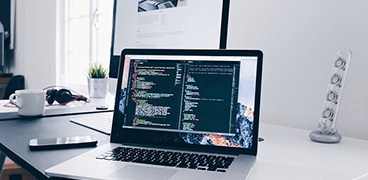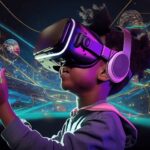In the ever-evolving landscape of technology and creativity, coding has emerged as a powerful tool for kids to express themselves in new and innovative ways. The fusion of coding and art has given rise to am innovative, fascinating genre known as digital art, where lines of code become the brush strokes, pixels on a screen transform into masterpieces. This article explores how coding can be used to create digital art, highlighting the limitless possibilities and the unique advantages it offers to your young artist.
How Coding Can Be Used To Create Digital Art
Coding, traditionally associated with computer science and software development, has transcended its functional boundaries to become a means of artistic expression. This fusion of technology and art has led to the creation of digital art, which encompasses a wide array of forms, including generative art, interactive installations, digital painting, and more. At the core of digital art lies the idea that coding is a language through which artists can communicate their creative visions.
One of the most compelling aspects of using coding for digital art is the ability to harness the power of algorithms. Algorithms are sets of instructions that can be used to generate complex and intricate patterns, shapes, and visuals. Artists can manipulate these algorithms to produce artworks that would be nearly impossible to create by hand. Generative art, for example, relies on algorithms to create art that is ever-evolving, unpredictable, and unique in each iteration. This dynamic quality adds a new dimension to the art form, inviting viewers to engage with the process as well as the final product.
Coding in digital art also enables interactivity and immersion. Artists can create interactive installations where viewers become active participants, influencing the artwork’s behavior or appearance through their actions. This immersive experience blurs the line between the artist and the audience, fostering a deeper connection and engagement with the art. Interactive digital art can be found in galleries, public spaces, and even online platforms, allowing for a broader and more accessible audience.
Coding also democratizes the creation of art by making it more accessible to a broader range of people. With the right tools and resources, anyone can learn to code and start creating digital art. Furthermore, coding facilitates collaboration between artists and technologists, leading to exciting cross-disciplinary projects that combine the best of both worlds.
The Power Of Digital Art
In the modern age of technology and creativity, digital artworks have emerged as a powerful and transformative force within the realm of art. These innovative creations, often produced through digital media and technology, possess a unique set of attributes that set them apart from traditional forms of art.
1. Interactivity and Engagement
Digital artworks often incorporate interactive elements that encourage viewer engagement. Whether it’s an interactive installation, a virtual reality experience, or a digital painting with hidden layers, these forms of art invite audiences to become active participants rather than passive observers. This interactivity enhances the viewer’s connection to the artwork, making the experience more personal and memorable.
2. Dynamic and Ever-Changing
Unlike static traditional artworks, digital art can be dynamic and ever-changing. Artists can use algorithms and code to create pieces that evolve over time, responding to real-world data, user input, or random variables. This dynamism adds an element of unpredictability and excitement to the art, allowing it to adapt and remain relevant in an ever-evolving world.
3. Preservation and Reproducibility
Digital art offers new possibilities for preserving and reproducing artistic works. Unlike traditional art, which may deteriorate over time or be limited to a single original piece, digital artworks can be easily archived, reproduced, and shared without losing quality. This facilitates the preservation of artistic legacies and ensures that a broader audience can experience and appreciate the work.
How To Foster Artistic Creativity Through Coding
Coding is not just a tool for programmers, but a medium through which artists can explore new dimensions of creativity through digital art.
1. Exploring New Avenues of Expression
Coding provides artists with a fresh canvas on which to paint their ideas. It allows them to explore new forms of expression, from generative art that evolves over time to interactive installations that engage the senses. The versatility of code empowers artists to break free from the constraints of traditional mediums, encouraging them to push boundaries and experiment with novel concepts.
2. Automation and Repetition
One of the key advantages of coding in artistic creativity is its ability to automate repetitive tasks. This automation liberates artists from tedious processes, enabling them to focus on the core of their creative vision. Whether it’s generating intricate patterns or manipulating large datasets, coding streamlines the production process, providing more time for artists to nurture their ideas.
3. Cross-disciplinary Collaboration
Collaboration between artists and technologists has become increasingly common, resulting in groundbreaking projects that combine the best of both worlds. Coders can work hand in hand with artists to bring their visions to life. This synergy leads to the creation of innovative artworks that merge artistic sensibilities with technological expertise, opening up new dimensions of creativity.
4. Iterative Creativity
Coding encourages an iterative approach to creativity. Artists can easily tweak and refine their work, experiment with different parameters, and visualize the immediate results. This iterative process fosters a sense of curiosity and a willingness to embrace trial and error, ultimately driving the evolution of an artist’s style and ideas.
5. Accessibility and Inclusivity
Coding encourages an iterative approach to creativity. Artists can easily tweak and refine their work, experiment with different parameters, and visualize the immediate results. This iterative process fosters a sense of curiosity and a willingness to embrace trial and error, ultimately driving the evolution of an artist’s style and ideas.
6. Incorporating Data and Technology
Coding allows artists to incorporate data and technology into their creative processes. Whether it’s using data visualization techniques to convey complex information or leveraging augmented reality to create immersive experiences, artists can infuse their work with contemporary elements that reflect the digital age.
Conclusion
The synergy between art and coding represents a dynamic frontier for artistic creativity. It offers artists the opportunity to explore new forms of expression, collaborate across disciplines, streamline production processes, and engage with technology in innovative ways. By embracing coding as a tool for creative expression, artists can foster their imagination, push boundaries, and contribute to the ever-evolving landscape of art in the digital age. As technology continues to advance, the possibilities for artistic creativity through coding are limitless, ensuring that this dynamic relationship will remain a source of inspiration for generations to come.
Unleash Your Child's Inner Artist with CampusTop
Schedule a First-Time Lesson with us, and we’ll provide you the assistance you require! We’re eager to help you realize your child’s artistic potential through code. Our coding tutors can help your child’s programming education by employing simple and entertaining Scratch-based teaching exercises. We’ve developed a curriculum for online sessions, so you don’t have to worry about where to begin your at-home coding studies.






